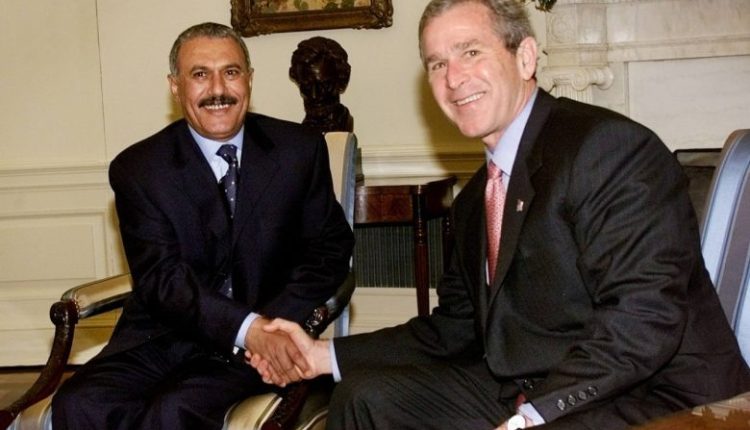How the Deposed Ali Abdullah Saleh Turned Yemen into a Hub of American Hegemony and Political Subservience
Ali Abdullah Saleh — infamously known as “Afash” — was not merely an authoritarian ruler who happened to cling to power by chance. He was a deliberately groomed instrument of American and Saudi intelligence, designed to destroy Yemen from within and transform it into an open arena for foreign domination.
For thirty-three years, Yemen remained hostage to dubious deals, proxy wars, and systematic looting, until the state became a fragile entity run by a corrupt family from a fortified presidential palace — while real decisions were issued from the American embassy in Sana’a. But the September 21, 2014 Revolution came to upend that reality, restoring Yemen’s sovereign decision and closing a dark chapter of treachery and dependency.
Afash: The Agent of the American–Zionist Project in Yemen
From the moment he seized power in 1978, Saleh wove tight relations with Riyadh and Washington, then secretly extended his ties to Tel Aviv through intermediaries in the Horn of Africa. He served as a bridge between the enemies of the region and the land of faith and wisdom, executing their agendas in exchange for regime survival and protection of his looted wealth abroad.
Under the pretext of “counterterrorism,” he opened Yemeni airspace to American drone operations, allowed the CIA to establish secret bases, and supplied intelligence on his political and national rivals to justify repression and consolidate his rule.
His covert relations with the Zionist entity took an even more dangerous form — facilitating the passage of Israeli vessels through the Bab al-Mandab Strait and offering logistical and technical support in return for direct intelligence assistance. Later documents revealed secret meetings between Mossad officers and members of Saleh’s regime — all part of a coordination effort to secure Zionist control over the Red Sea and its strategic waterways.
Looting of Wealth and the Starvation of the People
Saleh’s political philosophy was built on one rule: “Family first, the nation last.” He surrounded himself with a narrow circle of relatives — his son Ahmed commanding the Republican Guard, his nephews controlling national security, central forces, and financial institutions. The state turned into a private enterprise that traded loyalty and bought silence.
During the first decade of the 2000s, over $50 billion in oil and gas revenues vanished — siphoned into offshore accounts or channeled into fake projects. Meanwhile, the family’s economic lobbies flooded the domestic market with imported goods to destroy local production and turn Yemen into a dependent consumer economy.
Public lands and state properties were distributed as gifts and privileges to regime loyalists, until the homeland itself became a personal estate for a ruling clan that saw the people merely as instruments for its wealth and survival.
The Destruction of Air Defenses: The Grand Betrayal
As part of the broader American control project, Saleh’s regime signed a secret agreement with Washington to dismantle Yemen’s man-portable air defense systems under the pretext of “fighting terrorism.”
In 2004, under the supervision of Saleh’s nephew Ammar Mohammed Abdullah Saleh, negotiations were held with an American delegation to hand over and destroy the missiles. Implemented by the U.S. company RONCO, over 1,263 air defense missiles — including SAM-7 and Strela systems — were destroyed in Al-Jad’an and Ma’rib, stripping Yemen of its ability to defend its skies.
WikiLeaks documents later confirmed these details, quoting Saleh as telling a U.S. official, “We don’t need them,” pledging not to purchase replacements. In doing so, he effectively disarmed the nation, paving the way for full U.S. military and strategic domination.
American Hegemony: From Total Guardianship to Humiliating Exit
Following the events of September 11, 2001, Washington turned Yemen into a testing ground for its aggressive “counterterrorism” policies. The U.S. ambassador became the de facto ruler of Sana’a, interfering in decisions of the government, military, and judiciary, dictating policy to ministers and political parties alike.
The U.S. also worked to fracture Yemen’s social fabric — fueling sectarian and regional divides, reshaping education and media to promote American ideology, and eroding the faith-based identity of the Yemeni people.
At the height of this subservience, the American ambassador even chaired official meetings inside ministries and military compounds, effectively turning the U.S. embassy into a “central command” for a politically occupied Yemen.
But this domination was short-lived. Thanks to the awareness and defiance of the Yemeni people, the September 21 Revolution erupted — ending U.S. control and forcing the American ambassador and military personnel to flee Sana’a in humiliation, af

